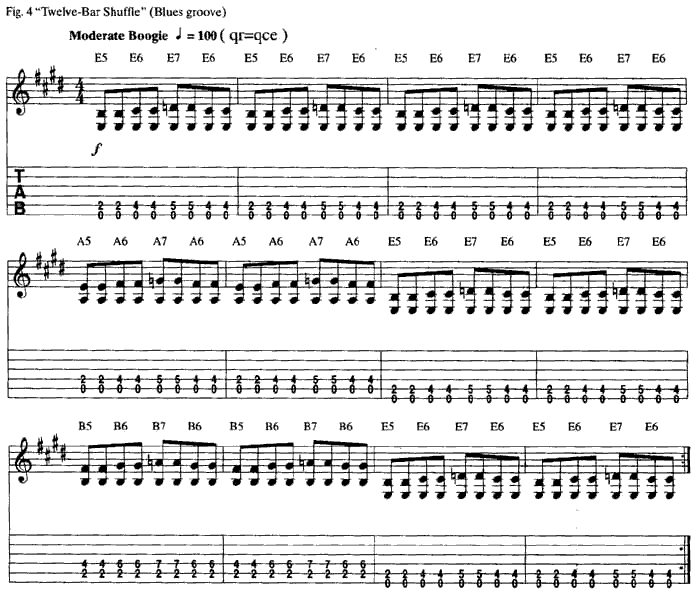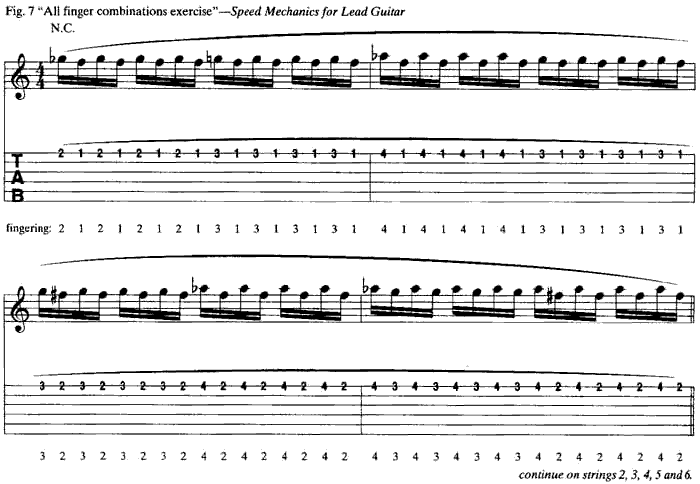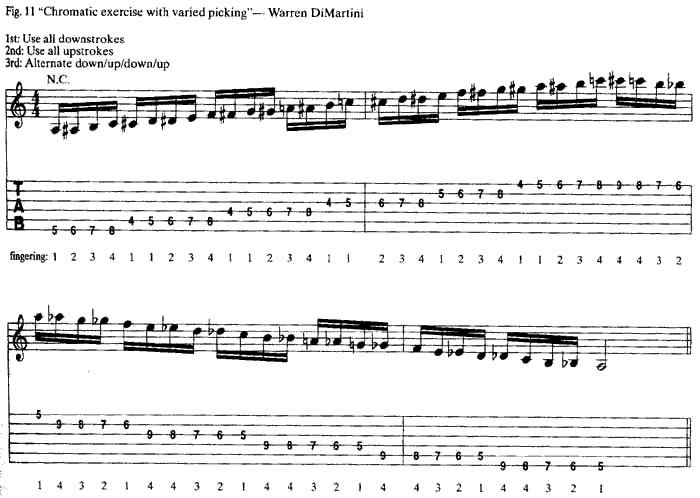
Warming Up
Improve Your Performance with these Physical, Musical, and Exercise Routines
By Troy Stetina
GuitarOne
Rewritten and updated (c) 2020 Troy Stetina
So you're sitting in your bedroom practicing, and after a few hours you're really moving on a particularly difficult solo. "I've got it!" you say. You play it again, challenged yet confident, and once again you pull it off. Great. You set your guitar down, comfortable in the knowledge that you have nailed it. But later that day, something strange happens...
.
You grab your guitar to show off your latest conquest to a friend--or perhaps your guitar teacher--and your fingers don't respond the same. You can't create the same flow, so you push harder. You screw up. You try again and totally lose it! After a third equally unpleasant whack at the thing, you exclaim in frustration, "I don't understand why I can't play this! I was just flying over it a few hours ago."
What's going on here? The answer lies in two words: warm up. Or, more specifically in this case, a lack of warm up.
The fact is, you just cant play your best at the drop of a hat; or to say it another way, your abilities are never constant. They fluctuate depending on your state of mind and body at any given moment. An extreme case demonstrates this fact quite well: Imagine you had to play immediately upon waking in the morning. How well do you think you'd do? Your muscles and tendons are stiff, your brain is still foggy, not to mention your eyes are still glued half shut (if your morning experience is anything like mine). Yeah, you could play a little, but it's not exactly showing your abilities in their best light!
Okay then, obviously some times are better than other times. Let's imagine we have a ten-point scale to rate your level of readiness. Zero is "first thing in the morning," and ten is right at your absolute peak--you are sharp, fully warmed up, feeling creative, and everything is clicking. What level do you have to be at in order to pull off that solo? A nine or ten. And what level are you right now? Say four or five. So if you try to force it right now, you're gonna choke! You have to get up near ten first, before you try to pull off your hardest stuff, and for that you need a good warm up.
What is the best way to warm up? All the various techniques break down into three basic categories. First, there are the physical approaches--stretching and the like. Second, we can simply play music, or jam. And third, we can play specially crafted "warm-up exercises."
The Physical Approach
We'll start with the physical approach-working your muscles to get the blood flowing, stretching the muscles and tendons, and literally warming the temperature of your hands and forearms. In this vein (pun intended), Steve Morse's suggestions are an excellent starting point: "The first step is to develop the good habit of washing your hands in warm water. This is to get your hands warmed up and, of course, get them clean. Getting your hands literally warmed up makes it easier to stretch."
Next, you could try stretching and working the muscle groups you are going to be calling on. This also warms the temperature of your hands. Try a Grip Master, or simply squeeze a tennis ball repeatedly for a minute. The idea is not to get an intense workout, but just to get the blood flowing a little. As Ritchie Sambora admits: "If I don't have enough time to warm up sufficiently, I use the Grip Master. That will get you close because it works all those muscles."
And of course you can go further, stretching and massaging each of the muscles and joints. Start with each finger and move on to the hand. Then push and pull all the fingers back and forth to stretch each wrist slowly over its range of motion. Massage the forearms a little and stretch out the elbows and shoulders. Try this once and see how it feels.
The Musical Approach
The second "category" for warming up is simply to jam on music. It could be full tunes, or perhaps just riffs or grooves. It could be all improvised, covers, or some of both. The main thing to keep in mind is that your purpose here is to get warmed up and not to set any new land speed records, so don't be overly aggressive. Let the music power your fingers, and before long you'll notice your vibrato getting more intense, your speed coming on naturally, and your bends getting easier.
Extreme's Nuno Bettencourt favors warming up with this jamming approach before shows: "The best way to warm up for me is playing. We have a small drum kit in the dressing room, and ... I just jam along with [the drummer]. You start off nice and slow, whether it's a pentatonic thing or anything you choose. Play with a slow pace for a while and then sort of build it up. At the end of my warm up [we're] out of control."
To give you something specific to try out this build-up style, jamming approach, I've collected a few riffs for you as samples. Each one focuses on a different technique, or aspect of playing.
Figure 1 is Hendrix's immortal "Purple Haze" riff. This famous single note lead-style riff works as a great starting point with its moderately slow pace, left hand position shifts and slight bending.

Figure 2 is the riff from Foo Fighters's "I'll Stick Around." This faster-tempo riff focuses on shifting barre chords.

Figure 3 is from Metallica's "One." This one hones in on the picking hand. Don't worry about playing the full songs, just jam on each riff for a bit. Also, don't hesitate to go off and improvise your own variations on any of them.

Getting into and holding a groove for a few minutes is another excellent approach. When you are in a groove, the rhythm flows throughout your entire body. Rhythm is motion and motion is fluid-the opposite of stiffness. Blues and funk grooves both work nicely, loosening you up generally, without regard to specific techniques, so give each a try.
Figure 4 is a typical 12-bar blues shuffle, with 6th and 7th comping.

Figure 5 is the funky central riff from the Red Hot Chili Peppers' "Suck My Kiss."

A third musical warm-up approach is simply to put on a favorite record or CD--one which you already know the songs-and just play along, improvising. Carlos Santana favors this approach: I don't usually sit down and practice scales. I think that is the most boring thing. It's like eating a sprout sandwich ... I play to records a lot. I play along with John Coltrane's "Naima" and "My Favorite Things" and try to hang in there with McCoy (Tyner) and Elvin (Jones). Once the record is over, that's a good warm-up exercise."
The Exercise Approach
Some players, such as Steve Vai, Steve Morse, and Marty Friedman, often use specifically designed exercises as warm-up tools. If you're the patient, detail-minded type, you'll probably dig this approach as it is very systematic and can be quite effective. For others, exercises just drive them nuts. Give it a shot and see if they're for you.
One thing to keep in mind though, in the words of Marty Friedman: "You can use anything that moves the fingers very, very slowly. No need to play warm-up exercises fast. What's the point?" Precisely. These are warm-up exercises, not speed-honing exercises. So don't push it. Focus on quality and having total control over the movement of each finger. After ten or twenty minutes of these, your fingers should really be feeling it.
Figures 6a-6c come via Steve Vai, featuring an exhaustive array of two-note-per-string mechanical sequences. With it, Steve suggests: "The metronome speed is up to the user. You have to start really slow so you doubt even make one little mistake." For these, play the patterns given using each of the fingering options located below the staff.

Figure 7 is lifted right from one of my books, Speed Mechanics for Lead Guitar. It offers a condensed version covering the same finger combinations as Fig. 6. But this time we'll use a legato approach, playing with hammer-ons and pull-offs.

Now let's try some three-note-per-string patterns in Figure 8, courtesy of Steve Morse.

Figure 9, again from Speed Mechanics for Lead Guitar, takes the three-note-per-string idea but conforms it to an A natural minor scale, a la the ever-terrifying, drill-wielding axeman Paul Gilbert.

In Figures 10a and 10b, Marty Friedman mixes up the three-note sequence a little, moving it up and back down the neck. Then he stretches out, adding a string-skipping approach. Slowly, slowly, slowly.
Next we'll try picking a line using three notes per string. Moving between strings like this requires the pick to move farther in the same amount of time. Therefore it is difficult to maintain the same speed. Expect to take this one a little slower. Figure 14 shows the basic picking pattern. Start with a downstroke and lead with an upstroke to the next string. Some people have a tough time with this. If it's a problem for you, exaggerate the picking motion until you get it down. Then go back to small motions.

Figure 11 is the chromatic exercise employed by Warren DiMartini. He throws a curve in on the picking side, however. First, he plays it all with downstrokes for a while. Then all upstrokes for a while. Finally, he gets around to alternate picking.

Neal Schon adds a totally different warm-up approach, with string bending and vibrato. "Use fast vibrato, slow vibrato, use extremely slow vibrato, and make sure that note always comes back to the top when you- come off it. Practice just holding the note forever while stretching up to it. I think that's a great warm-up exercise for all new guitar players that play a million notes. Practice just hitting one note and making it sing" (Figure 12).

To wrap it up, take a whack at Figure 13, also drawn from Speed Mechanics. Here we blend Schon's bending fetish with another popular Vai exercise approach of playing scales up a single string.

Of course, nearly any exercise could be an effective warm-up exercise. The idea is to get your fingers loosened up and reacquainted with the fretboard. So feel free to adopt, alter, or abandon these, as you wish. Or trash the whole exercise approach altogether if it doesn't work for you. After all, if you find exercises boring, they're not going to get you very warmed up! Everyone is different. Use what works for you.
You're Gonna Do it Anyway, So Why Not Do It Right?
The fact is, you are going through a warm-up process every time you start to play, whether you know it or not. I mean, your speed and accuracy are always a little less at first, and rise a bit as you get into it. The only difference with making a dedicated warm up session is that you are taking control of the process.--so you can show your best when the spotlight moment hits. Additionally, you wont be risking the strain injuries that can result from pushing too hard, too fast.





